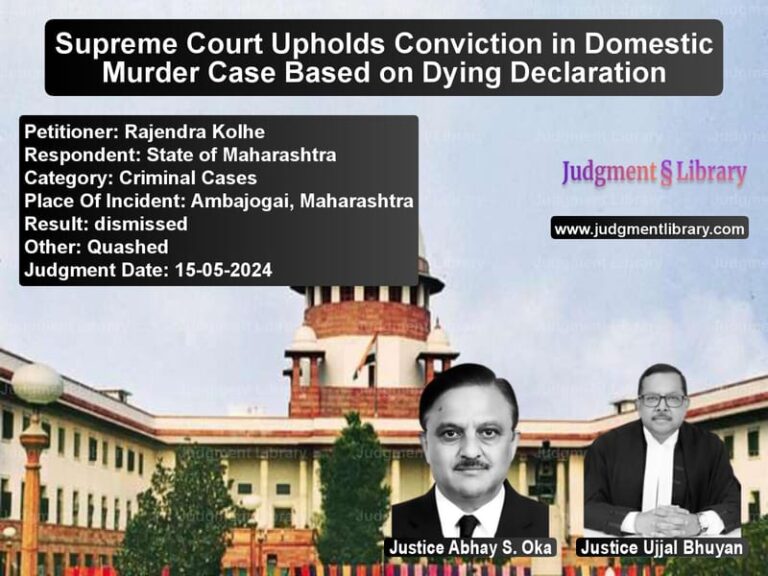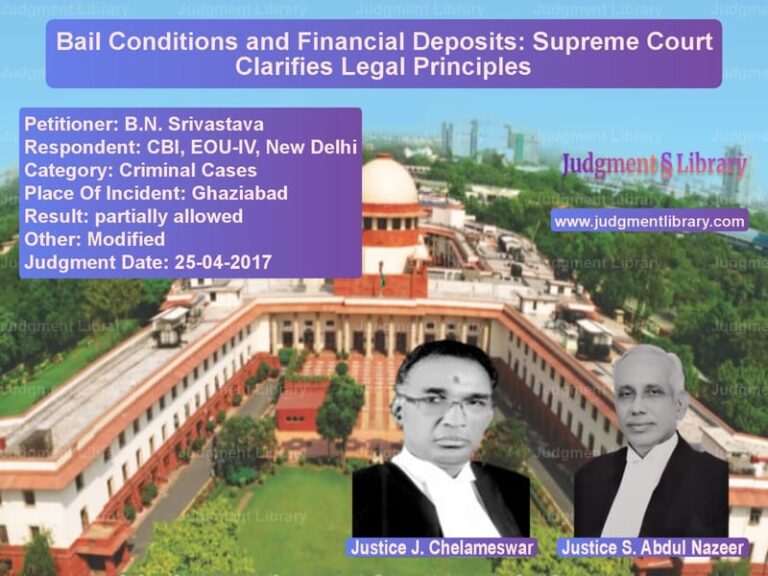Supreme Court Ruling on Unlawful Assembly and Criminal Liability: A Case of Mob Violence
The case of The State of Uttar Pradesh vs. Ravindra @ Babloo and Others addresses the crucial issue of unlawful assembly and the criminal liability of its members under Section 141 of the Indian Penal Code (IPC). The appeal stems from the acquittal of the accused by the High Court, which reversed their conviction on charges of murder, attempt to murder, and rioting under various sections of the IPC. The Supreme Court was tasked with examining whether the High Court’s acquittal was justified, considering the nature of the injuries sustained by the victims, the conduct of the assailants, and the corroborative ocular and medical evidence presented in the trial.
Background of the Case
The incident in question took place on January 10, 2002, when the two deceased, Mahendra Singh and his son Lokesh Singh, were attacked by a group of armed individuals led by the accused. The attack occurred in broad daylight, and it was fueled by a longstanding enmity over a land dispute. The prosecution’s case was supported by the testimonies of the injured eyewitnesses, PW-1 (Mahendri), the wife of Mahendra Singh, and PW-3, the wife of Lokesh Singh, both of whom identified the assailants as the respondents. The assailants were reportedly armed with spades, rods, and a country-made pistol, and they pursued the victims, attacking them mercilessly even after they had fallen to the ground.
The trial court convicted the accused under Sections 302/149, 307/149, 147, 148, and 452 of the IPC, finding them guilty of murder, attempt to murder, rioting, and house trespass. However, the High Court overturned this conviction, citing discrepancies between the ocular and medical evidence. The High Court believed that the injuries found on the deceased and injured did not match the weapons allegedly used by the assailants and that the number of assailants was less than what was described by the witnesses.
The State of Uttar Pradesh filed an appeal before the Supreme Court, challenging the acquittal of the accused, while the respondents maintained that the acquittal was justified based on the discrepancies in the evidence.
Legal Issues Addressed
The Supreme Court addressed several pivotal legal questions in this case:
- Whether the acquittal of the respondents by the High Court was justified, given the evidence of the injuries sustained by the deceased and the injured eyewitnesses.
- Whether the members of the unlawful assembly, armed with weapons, could be convicted based on their shared common object and conduct during the commission of the offence.
- Whether discrepancies between the ocular and medical evidence were sufficient to overturn the trial court’s conviction of the respondents.
- Whether the prosecution had sufficiently proved the existence of an unlawful assembly and the common object shared by the accused.
Arguments by the Petitioner (The State of Uttar Pradesh)
The appellant, represented by Mr. Ravindra Kumar Raizada, presented the following arguments:
- The High Court erred in setting aside the conviction based on minor discrepancies between the ocular and medical evidence. The core of the case was that the assailants were part of an unlawful assembly, and the nature of the injuries indicated the severity of the assault.
- The presence of PW-1 and PW-3, both injured witnesses, corroborated the version of events provided by the prosecution. The injuries on the deceased and injured were consistent with the weapons used by the assailants, and the common object of the unlawful assembly was to commit murder.
- The High Court’s finding that the respondents were not armed with weapons capable of causing the injuries was incorrect. The prosecution had established that the assailants were armed with spades, rods, and a pistol, all capable of inflicting fatal injuries.
- The acquittal was unjustified, as the respondents’ actions in pursuing and attacking the victims after they had fallen to the ground were indicative of a premeditated act of murder, and their participation in the unlawful assembly was clear.
Arguments by the Respondent (Ravindra @ Babloo and Others)
The respondents, represented by Mr. Ankul Chandra Pradhan, countered with the following arguments:
- The acquittal by the High Court was based on a well-reasoned examination of the discrepancies between the ocular and medical evidence. The injuries sustained by the deceased did not align with the weapons allegedly used by the assailants, and this inconsistency raised doubts about the prosecution’s case.
- The prosecution’s case lacked sufficient corroboration, and the presence of the injured eyewitnesses, PW-1 and PW-3, could not be relied upon entirely to convict the respondents. If two views are possible based on the evidence, the acquittal should not be disturbed.
- The injuries sustained by the deceased and the injured were not severe enough to warrant a conviction for murder. The respondents were not armed with weapons capable of causing such injuries, and the medical evidence was inconsistent with the charges of attempted murder and rioting.
- The High Court correctly found that the respondents were not part of an unlawful assembly, and there was no clear evidence to suggest that they shared a common object to commit murder or rioting.
Supreme Court’s Observations and Ruling
The Supreme Court bench, comprising Justice Ashok Bhushan and Justice Navin Sinha, made the following key observations:
1. The Presence of an Unlawful Assembly
The Court found that the accused were part of an unlawful assembly, which had a common object of causing harm to the victims. The Court observed:
“The assembly, which was armed and entered the house of the deceased, pursued and attacked them, causing death and injury to the victims, was clearly an unlawful assembly. The common object of the assembly was to inflict harm upon the victims, and the actions of the assailants were consistent with that object.”
2. Ocular vs. Medical Evidence
The Court addressed the discrepancy between the ocular and medical evidence and emphasized the importance of eyewitness testimony in cases of mob violence:
“Minor variations between the medical and ocular evidence cannot overshadow the credibility of the eyewitnesses who were present at the scene. The presence of injuries on the deceased and the injured, consistent with the type of weapons used, corroborates the testimony of the eyewitnesses.”
The Court ruled that the inconsistencies in the medical evidence did not invalidate the eyewitness testimony or the case presented by the prosecution.
3. The Common Object of the Assembly
The Court clarified the concept of “common object” in the context of unlawful assembly and noted:
“The common object of the unlawful assembly was evident from the actions of the assailants, who, armed with deadly weapons, chased and attacked the victims. The fact that the respondents persisted with the assault, even after the deceased attempted to escape, showed their intent to cause harm and their shared common object.”
The Court found that the respondents were members of an unlawful assembly and had shared the common object of causing harm to the victims.
4. The Doctrine of Vicarious Liability
The Court also examined the concept of vicarious liability under Section 149 of the IPC and observed:
“Once it is established that the accused were part of an unlawful assembly, and the assembly’s common object was to commit harm, each member of the assembly is equally liable for the offence committed in the pursuit of that object. The presence of all the assailants, armed with weapons and persisting with the assault, establishes their vicarious liability.”
Final Judgment
The Supreme Court ruled as follows:
“The appeal filed by the State of Uttar Pradesh is allowed, and the acquittal of the respondents is set aside. The respondents are directed to surrender within four weeks to serve the remaining period of their sentence. The trial court’s conviction is upheld.”
The Court emphasized that the respondents’ participation in the unlawful assembly and their intent to cause harm to the victims was clear from the evidence presented in the case.
Implications of the Judgment
This ruling has significant implications for criminal jurisprudence in cases involving mob violence and unlawful assembly:
- Unlawful Assembly: The judgment reaffirms the importance of proving the existence of an unlawful assembly and the common object shared by its members in cases of mob violence.
- Ocular Evidence: The judgment emphasizes the primacy of eyewitness testimony in cases of violent crimes, even when discrepancies arise between medical and ocular evidence.
- Vicarious Liability: The ruling reinforces the doctrine of vicarious liability in cases involving unlawful assemblies, where all members of the assembly are equally responsible for the offences committed in furtherance of the common object.
Conclusion
The Supreme Court’s ruling in The State of Uttar Pradesh vs. Ravindra @ Babloo is a critical decision that clarifies the legal principles surrounding unlawful assemblies, vicarious liability, and the role of eyewitness testimony in criminal trials. The judgment underscores the need for careful scrutiny of the actions of accused individuals in cases of mob violence and affirms the application of criminal liability based on the common object of the assembly.
Petitioner Name: The State of Uttar Pradesh.Respondent Name: Ravindra @ Babloo and Others.Judgment By: Justice Ashok Bhushan, Justice Navin Sinha.Place Of Incident: Uttar Pradesh.Judgment Date: 18-12-2019.
Don’t miss out on the full details! Download the complete judgment in PDF format below and gain valuable insights instantly!
Download Judgment: The State of Uttar P vs Ravindra @ Babloo an Supreme Court of India Judgment Dated 18-12-2019.pdf
Direct Downlaod Judgment: Direct downlaod this Judgment
See all petitions in Murder Cases
See all petitions in Bail and Anticipatory Bail
See all petitions in Terrorist Activities
See all petitions in Judgment by Ashok Bhushan
See all petitions in Judgment by Navin Sinha
See all petitions in allowed
See all petitions in supreme court of India judgments December 2019
See all petitions in 2019 judgments
See all posts in Criminal Cases Category
See all allowed petitions in Criminal Cases Category
See all Dismissed petitions in Criminal Cases Category
See all partially allowed petitions in Criminal Cases Category







